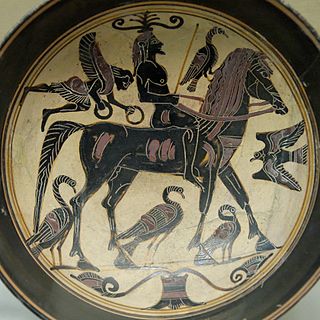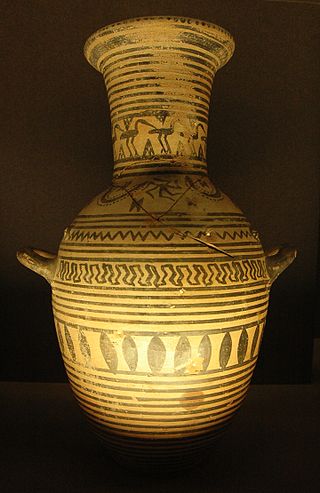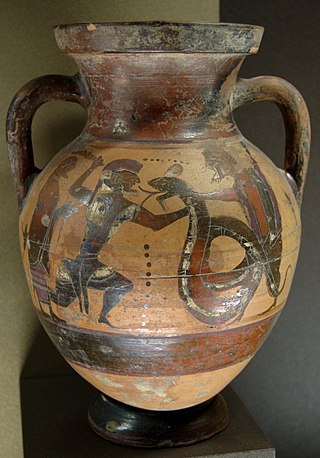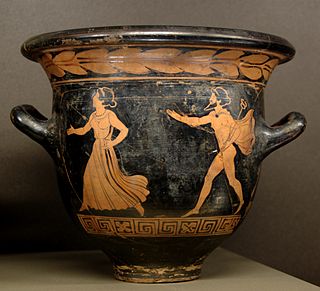
Black-figure pottery painting, also known as the black-figure style or black-figure ceramic, is one of the styles of painting on antique Greek vases. It was especially common between the 7th and 5th centuries BCE, although there are specimens dating as late as the 2nd century BCE. Stylistically it can be distinguished from the preceding orientalizing period and the subsequent red-figure pottery style.

Red-figure vase painting is one of the most important styles of figural Greek vase painting.

The C Painter was one of the most important Attic black-figure vase painters. His works date to circa 575–550 BC. His conventional name was allocated by the archaeologist John Beazley. The C stands for "Corinthianising", a reference to the strong influence of Corinthian vase painting on the artist. He was successor to the Comast Group and used the relatively old-fashioned range of vessel shapes preferred by that group, including lekanis, tripod kothon and skyphos. In contrast, he also painted quite innovative lekythoi with pronounced shoulders, although the more conservative Deinaeira type was still in use by some workshops at his time. The C Painter was the first Attic vase painter to paint cups without an offset lip, the Merrythought cup.

The Tyrrhenian amphora is a specific shape of Attic black-figure neck amphora. Tyrrhenian amphorae were only produced during a short period, about 565 to 550 BC. They are ovoid in shape and bear striking decorations. The handle is usually decorated with a lotus-palmette cross or vegetal tendrils. It always terminates in a red-painted ridge. The vase body is painted with several friezes. The uppermost of these, on the shoulder, is usually especially notable. It often contains mythological scenes, but the first erotic motifs in Attic vase painting also occur here. Unique motifs include the sacrifice of Polyxena. Often, the figures are explained by added inscriptions. The other friezes, usually two to three in number, are often decorated with animals. At times, a frieze is replaced with a vegetal band.

A Nikosthenic amphora is a type of Attic vase invented in the late 6th century BC by the potter Nikosthenes, aimed specifically for export to Etruria. Inspired by Etruscan Bucchero types, it is the characteristic product of the Nikosthenes-Pamphaios workshop.

The Arkesilas Painter was a Laconian vase painter active around 560 BC. He is considered one of the five great vase painters of Sparta.

The Rider Painter was a Laconian vase painter active between 560 and 530 BC. He is considered one of the five great vase painters of Sparta.

Boeotian vase painting was a regional style of ancient Greek vase painting. Since the Geometric period, and up to the 4th century BC, the region of Boeotia produced vases with ornamental and figural painted decoration, usually of lesser quality than the vase paintings from other areas.

The term Kabiria Group describes a type of Boeotian vases decorated in the black-figure technique. The term can also be used describe the artists producing vases of the type.

Euboean vase painting was a regional style of ancient Greek vase painting, prevalent on the island of Euboea.

East Greek vase painting was a regional style of ancient Greek vase painting, produced by the eastern Greeks. In spite of the region's wealth, the pottery was rather unremarkable in comparison to other areas. The clay is red-brown to pink and often contains mica inclusions. Many regional sub-styles of East Greek pottery existed.

Rhodian vase painting was a regional style of East Greek vase painting, based on the island of Rhodes.

The Pontic Group is a sub-style of Etruscan black-figure vase painting.

Pseudo-Chalcidian vase painting is an important style of black-figure Greek vase painting, dating to the 6th century BC.
Cycladic vase painting was a regional style of Greek vase painting, produced in the Cycladic islands.

Ionic vase painting was regional style of ancient Greek vase painting.

Klazomenian vase painting was a regional style of ancient Greek vase painting, belonging to the East Greek representations of that form of art.

Lucanian vase painting was substyle of South Italian red-figure vase painting, produced in Lucania between 450 and 325 BC. It was the oldest South Italian regional style. Together with Sicilian and Paestan vase painting, it formed a close stylistic community.

Melian Pithamphorae or Melian Amphorae are names for a type of large belly-handled amphorae, which were produced in the Archaic period in the Cyclades. On account of their shape and painted decoration in the Orientalising style, they are among the most famous Greek vases. The amphorae are dated to the seventh and early sixth centuries BC; the last of them was made in the 580s. They were used as grave markers with the same function as the later grave statues and reliefs and were dedicated as cult objects in sanctuaries. With the increasing importance of sculpture in these roles, the production of these vases came to an end.

The Dionysus Cup is the modern name for one of the best known works of ancient Greek vase painting, a kylix dating to 540–530 BC. It is one of the masterpieces of the Attic black-figure potter Exekias and one of the most significant works in the Staatliche Antikensammlungen in Munich.





















